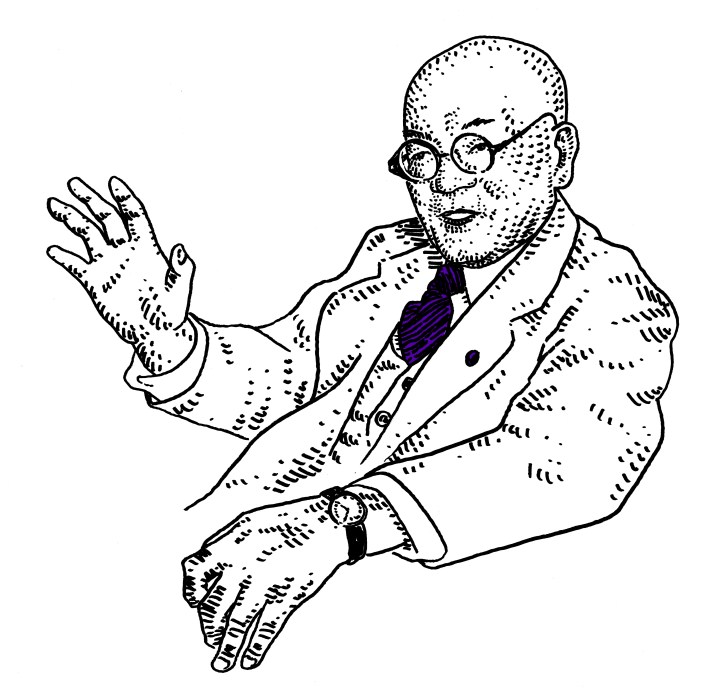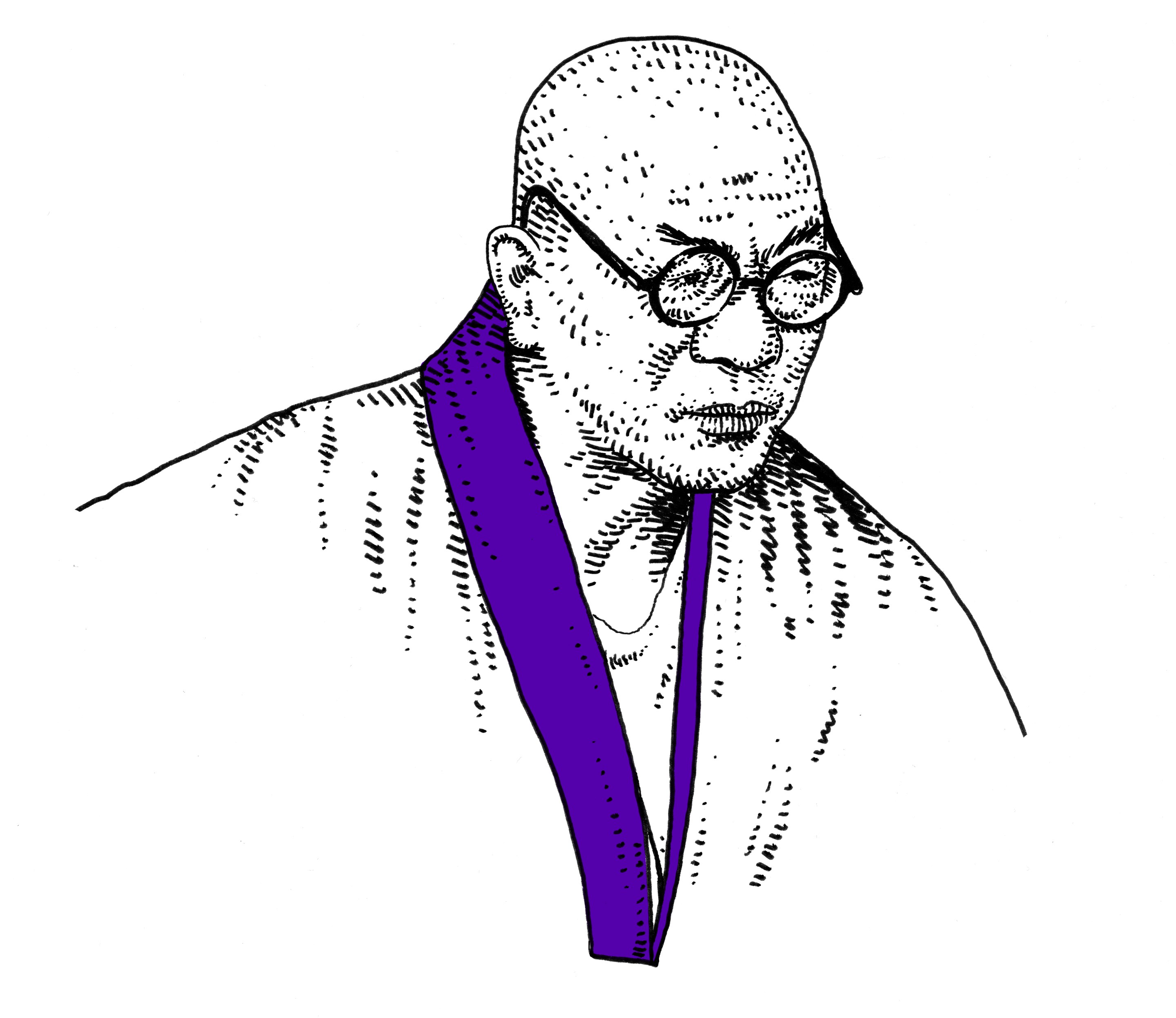This is an excerpt from Sports Stories, a weekly newsletter written by Eric Nusbaum and illustrated by Adam Villacin. Sports Stories covers the intersections of sports, history, and sports history. It’s free to subscribe, which we recommend you do here.
Some weeks the hardest thing about this newsletter is containing it. You start reading about something or someone, then writing, and all of a sudden you find yourself with a stack of library books and rings under your eyes and it’s 3 a.m. and you’re not really that close to getting it right, or capturing the vibe, or really imparting the true meaning of the subject, as if such a meaning can even be fully imparted consciously.
The life of Matsutaro Shoriki is a testament to how nothing can be contained. Everything spills into everything else. But I’ve tried to distill it here. I’m trying. Shoriki was born in 1885, in the middle of the Meiji era—during which Japan consolidated from a feudal society into a modern, centralized power.
(Forgive what I’m about to do, which is jump in time, skip details, and gloss over some interesting and important personages. Also if any of this interests you, put aside this browser window and go straight to your local bookstore to pick up Robert Fitts’ Banzai Babe Ruth.)
Shoriki’s life was a testament to the potential of the new Japan. He was not born especially wealthy or athletic or brilliant. He was a small-ish man but he was diligent and he was courageous. He studied to become a Judo master. After university, he worked for a decade as a police officer in Tokyo, rising in the ranks of his department before losing his job for what were essentially political reasons: He failed to prevent an assassination attempt against the future Emperor Hirohito. Actually stopping the attempt would have been impossible. But that didn’t matter.
In 1924, Shoriki did what any 38-year-old semi-disgraced ex-cop would do: he borrowed cash and bought a struggling newspaper called Yomiuri Shimbun. Shoriki did well with the paper, increasing its circulation the same way he had turned himself into a Judo master: through lots and lots of hard work. But he was not easily satisfied. Shoriki wanted his paper to be the country’s biggest and its most successful. Then in 1929, a friend got this crazy idea into his head: Shoriki could grow his newspaper’s circulation by having it sponsor a barnstorming baseball tour of Japan featuring Babe Ruth, then covering the tour with exclusives in the sports page.
Shoriki was not a huge baseball fan but he was an opportunistic businessman, and he could see clearly that by the late 1920s, Japan had become absolutely consumed by the sport. There was already a long tradition of American barnstorming teams coming over on tours. But bringing Babe Ruth to the country—that would be something else entirely. It was honestly kind of nuts. Babe Ruth was the biggest star in the world. He had transcended baseball and America and everything. Yomiuri Shimbun wasn’t even Japan’s premier newspaper.
Initially, Ruth said no. Then he said no again and again. But Shoriki was diligent. He continued to work the angles and continued to deploy his most trusted deputies to lure Ruth to Japan. Years went by. Ruth kept hitting home runs and rejecting pleas to come to Japan. Shoriki continued to nurture his paper and his stature as a publisher grew. He resembled something of a Japanese William Randolph Hearst—and indeed the two men would become business associates and develop a warm, albeit distant, personal relationship that saw them exchanging lavish gifts like live pumas and suits of armor.
But there was also something else happening in Japan at this time. Violent ultranationalist groups were proliferating in the country. These groups often overlapped neatly with organized crime—but they were relatively protected because the government under Hirohito was essentially sympathetic to their cause. One such group was called the War Gods Society.
The War Gods were affiliated with another Japanese paper: Tokyo Nichi Nichi. Decades earlier, Tokyo Nichi Nichi had been the first paper in the world to offer home delivery. But it had fallen on hard times. The War Gods Society was led by a Nichi Nichi employee named Sukeyasu Atsuta. He had a reputation for violence on behalf of the paper. Among other things, he led the War Gods Society in destroying a rival paper’s printing presses by throwing sand in them.
As Shoriki’s paper grew in stature and circulation, it ate into the readership of Atsuta’s employer. While Atsuta’s position as the leader of the War Gods Society did not technically fall under his employment with Nichi Nichi, there was an understanding that he and his compatriots might take action on behalf of the newspaper.
This became a more urgent matter when Babe Ruth began to finally soften to Shoriki’s entreaties. Fitts details the chase very well in Banzai Babe Ruth; what it came down to was Shoriki hiring a Japan-loving ballplayer named Lefty O’Doul, and O’Doul then getting his wife to befriend Ruth’s wife and daughter and fill their heads with stories about how wonderful Japan was. Finally, they convinced the Babe. The tour was finally on for after the 1934 season. It wasn’t just Ruth either, but Lou Gehrig, Jimmie Foxx, Earl Averill, and on and on.
But Ruth, of course, was the main attraction. He was not just the most charismatic and prolific ballplayer in America. He was not just the most famous. Ruth represented a way of life and a way of playing baseball that was practically inconceivable to Japanese fans. This is because it was completely incompatible with the Japanese thinking about the game. Here’s Fitts at length:
“From its beginnings...the Japanese had infused baseball with concepts borrowed from Bushido—the supposed code of the samurai warrior that had been reinvented to fit late-nineteenth century culture. Paramount among these concepts was the idea that sport enhanced not only the body but also the spirit. Intertwined with this was the virtue of frugality—a true samurai should concentrate on developing his spirit and not acquiring worldly goods. To play for money, rather than for personal enhancement, would sully the spirit.”
It’s hard to overstate what a rebuke Ruth, who was as famous for his partying as anything else, was to this way of thinking. And it’s also hard to overstate what a rebuke Shoriki’s tour was: this wasn’t sport as a means to self-improvement or discipline. This was far from the way of the true samurai. It was a publicity stunt to make money. Shoriki was in many ways a traditional man: short, bald, with glasses. He embodied Bushido even as he seemed to disregard it.

The tour was a threat to the circulation of the Tokyo Nichi Nichi and an affront to the conservative War Gods Society. The members decided that simply throwing sand in the presses of the Yomiuri Shimbun would not be sufficient. This called for more drastic action. The War Gods Society would send the strongest message possible. They would assassinate Matsutaro Shoriki.
The War Gods decided to hold off until after the American tour was over. There was too much attention on Shoriki now. They would wait until quiet returned to the country and the mogul returned to his normal routine at the paper in Tokyo. And while the War Gods plotted, the tour was largely successful. There were a few awkward cultural moments. And there were some triumphs for the Japanese fans as well.
In one game, a young pitcher named Eiji Sawamura struck out Ruth, Gehrig, and Foxx consecutively. It was a prescient and powerful moment. Sawamura would go on to become one of Japan’s greatest pitchers. The country’s version of the Cy Young Award is named for him. He would also go on to die in battle in World War II.
Shoriki saw business possibilities in the tour that extended beyond promoting his paper. He planned to turn the All-Star team he created into Japan’s first professional ballclub, the Tokyo Giants; then turn the Giants into the centerpiece of the country’s first professional baseball league. Babe Ruth had not just brought bluster and big smiles and the American way of playing baseball to Japan. He had brought the American business of baseball. At least that’s what he planned.
The War Gods Society learned the details of Shoriki’s routine. They met at their headquarters, a Judo dojo, and plotted the attack for an early morning, as Shoriki walked into his office. The assassin would be a man named Katsusuke Nagasaki. The weapon would be a samurai sword. In the cold February light, Nagasaki waited for Shoriki to arrive at the Yomiuri. The Americans had left a few months earlier. Shoriki was back to running his paper as before. Nagasaki lingered as the small man emerged from his car and strode through the front doors of the office. He followed him inside and struck Shoriki in the back of the head. Shoriki fell, grabbing at the wound. Bystanders helped him up the stairs to an infirmary.
Nagasaki went to a nearby police station and confessed. He told the police that he had attacked Shoriki because, as Fitts put it: “Shoriki had defiled the memory of the Emperor Miji by allowing Babe Ruth and his team to play in the stadium named in the ruler’s honor.”
Meanwhile, Shoriki survived. It was a long and painful recovery. He did indeed go on to start Japan’s first professional ballclub and its first professional league. But the attack on him proved more prescient than the events that preceded it. Japan’s rightward lurch continued. Ironically, after World War II, Shoriki was locked up by the occupying American forces for his role in disseminating the Empire’s propaganda. First he was stabbed by his countrymen for bringing the American Babe Ruth to Japan. Then he was imprisoned by Americans for serving his country.
After the war, Shoriki worked to expand pro baseball in Japan with the goal—unrealized—of creating a true World Series between Japanese and American clubs. In the 1950s, he oversaw the expansion of nuclear power in the country. Later it was revealed that he was working with the CIA on that.
Shoriki lived a long life for a man who was both stabbed in the head and imprisoned. When he died in 1969 at the age of 84, his ballclub, which had been borne of Babe Ruth’s long ago visit to Japan, featured a player named Sadaharu Oh. Oh, of course, was on his way to surpassing Ruth’s career home run record. He had achieved his mastery of the American sport by practicing for hours in a small dojo with a samurai sword.
Related Reading
The aforementioned Banzai Babe Ruth by Robert Fitts is honestly a wonderful, wild read.
The next thing I’d check out is this pamphlet from 1947 on Shoriki’s life and business record. The report details his spirituality (he was deeply interested in Buddhism) and the nature of his newspaper (apolitical.) It has a lot on his relationship with William Randolph Hearst—but no mention of the assassination attempt or Babe Ruth. It was declassified by the CIA in 1945.
For a quicker survey on Shoriki, here’s a feature from The Economist a while back.
Finally, I will take any opportunity to plug what is in my opinion the best baseball book ever written: Sadaharu Oh’s A Zen Way of Baseball.







